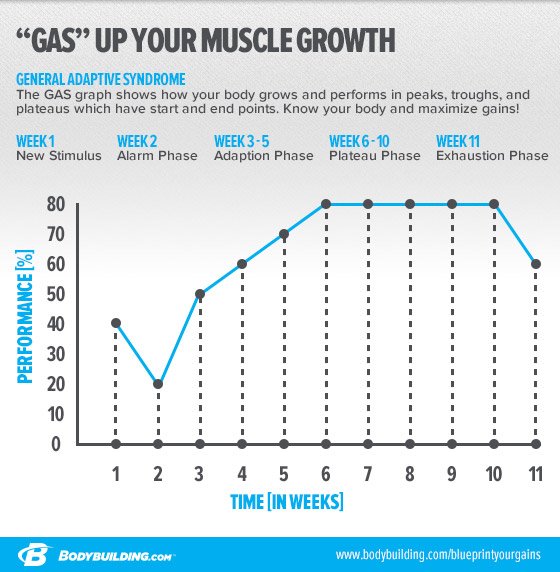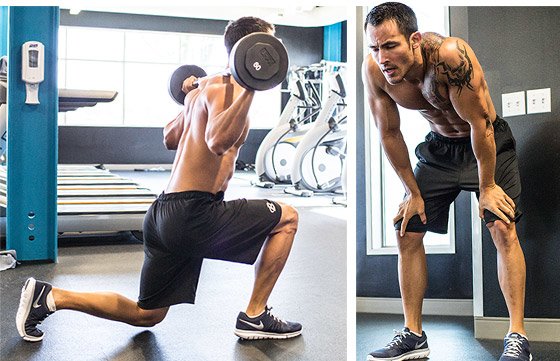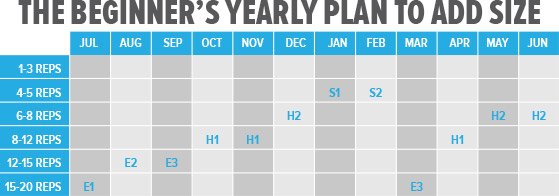One of the inalienable quirks of being human is that you always want more. From the moment you fill your lungs for the very first time as a newborn, being "more" is all you think about. You get damn good at it, too, because there's an unquenchable worldwide thirst for more horsepower, more information, more sex, more calories, more money, more strength, and more size.
Sadly, as most lifters and athletes will tell you, these gains don't last, and your eternal quest for more eventually hits a non-scalable wall—unless you adapt. It's the same with your love life—dating the same partner, eating at the same restaurants, and always doing the same things can't fulfill your emotional needs—unless you do these things with the one whose finger you end up putting a ring on, of course.
It turns out that variety is the spice of life, love, and muscle growth. You need to be flexible with fitness to ensure long-term growth and adaptation. I'll show you how.

Building Muscle Is A GAS
You want to pack on more muscle or improve performance, and the reason you can get your gains at the gym is because your body is the most adaptable thing on the planet—even more so than your iPhone. Unfortunately, you don't keep adapting endlessly.
A well-established study in the "British Medical Journal" calculated the exact speed and amount of adaptation your body is capable of—it's a formula called General Adaptive Syndrome (GAS), and it explains why you need variety to undergo continued adaptation.
The trick to long-term growth and performance is to treat your muscles like a player. Seduce them with a new workout every 4-8 weeks and their progress will keep you satisfied for as long as you're willing to make them sweat. Keep reading to find out how and why it works.
A Love Affair Of Muscle
The GAS graph shows that your body grows and performs in peaks, troughs, and plateaus that have a start and end point. Let's say you've just begun a new training cycle that you plan to stick with for as long as possible. It's time to walk through each phase of the GAS graph so you can see how it applies.

GAS Key
- 1 New stimulus
- 2 The alarm phase
- 3-5 The adaptation phase
- 6-10 Plateau
- 11 The exhaustion phase
Week 1 The New Stimulus
A training cycle starts the moment your muscles are confronted with a new stimulus. Let's say you usually do 4 sets of 8 reps on all your exercises. The new stimulus would be to do 3 sets of 15 reps on a totally new set of exercises or even on all the same group of exercises.
During the first week of this new training cycle, your body will adapt and might actually make gains. It'll be a refreshing change so you'll be motivated to see how far this new technique can take your physique and performance.
Week 2 The Alarm Phase
This is when your exercise performance might decline. You might not be able to push the same size weights you did the previous week or squeeze out as many reps. A set of 15 reps may feel long, arduous, and painful.
Frustration can fester as you wonder if this technique is the right one for you. You'll think about quitting, but may get a glimmer of hope in the final workouts of this week that will seem slightly easier and yield some strength increases.

Weeks 3-5 The Adaptation Phase
During these weeks, your body and brain reap the benefits of your hard work. Your nervous system becomes more efficient at instructing your muscles. This helps you use larger weights, which inflict micro-tears to your muscle fibers. They'll repair and grow back thicker and stronger, making you add muscle.
If you're training for sport, this is the time when you'll become fitter and improve upon your overall performance. Each week sees an improvement and you'll soon sport arms so powerful you could throw a lamb chop past a starving wolf.
The key to long-term progress is to stay in this phase for as long as possible. As soon as your gains taper off and begin to plateau (usually somewhere after week 5 or 6), you should take a break, then switch programs.
Weeks 6-10 Plateau
This is when you reach a point where your rate of adaptation slows down and you hit a muscle-building or performance plateau. The stimulus isn't different enough to cause your muscles to develop and they become stale. You won't necessarily lose strength or size, but you'll lift the same sized weights. It's a bit like gym purgatory.
Weeks 11 and Beyond The Exhaustion Phase
Your training has now become detrimental to your goals. Every rep you do is a cancer on your muscles; it bores them with the same tired stimulus. You'll get weaker, lose energy, and may even get ill. Your physique will deteriorate as you lose muscle and gain fat while your performance is in a slump.
You need to take at least two weeks rest or do a totally new type of training that is the antithesis of what you were doing.
The Moral Of The Story
For the best results, you should be flexible with your fitness. Let your muscles play the field of training techniques to keep growing and improving their performance.
Bear in mind that athletes usually adopt new techniques every 4 weeks while novices can keep making gains for up to 8-12 weeks using the same technique.
With that said, progress isn't always linear or constant. Sometimes it comes in batches when you least expect it. You might train hard for weeks with no results then, all of a sudden, progress slaps you in the face and your best lifts jump up by 44 pounds or you stack on 4 pounds of muscle.

The results can seem instant and almost seem effortless, but they are actually the reward of months of consistent and persistent effort. But the moment you feel the relationship with a training technique going sour because of a lack of gains, you have a few options: use a new training technique (way of exercising), take one or two weeks to rest from all training, or dramatically reduce your workout load by at least 60 percent.
Rest is never a bad thing, and it's recommended that you take a break whenever you hit a plateau or switch routines. But if you're motivated and keen on getting fast results, then feel free to jump straight into a new technique.
Should you choose to do this, make sure the new technique is vastly different from the last one you did or builds directly on your previous routines. Starting a new routine that's not different enough from the previous one means there won't be enough variation to trigger growth and progress.
This will keep you in a perpetual state of exhaustion which can lead to overtraining and burnout. For constant progress, decide on your goals and take your muscles out on the town by gathering information on several different types of training that are specific to your end goal.
Once you have all that information, then you can put it together in a long-term training plan that corrects failures and builds on success.
Always remember to mix things up to challenge your body and mind, because variety is the spice of a muscular life.
Crafting A Year-Long Plan
The following is a progressive plan to help a beginner progress to an intermediate lifter in less than a year.

1
Starting Off Easy
The high reps of endurance training will gradually accustom your muscles to being resistance training without any risk of injury. If you keep the rest periods low, it will also help you burn fat.
Strength Endurance Training
- Strength Endurance 1 (E1):
2 sets of 15-20 reps per exercise. Rest 30 seconds between sets - Strength Endurance 2 (E2):
3 sets of 12-15 reps per exercise. Rest 30 seconds between sets - Strength Endurance 3 (E3):
4 sets of 12-15 reps per exercise. Rest 30 seconds between sets
2
Picking Up Your Game
By this stage your muscles and nervous system will be attuned to getting put through its paces. You can now start gunning for size by decreasing the repetitions, increasing the size of the weights you use, and setting personal bests.
Try Bodybuilding Hypertrophy Training
- Hypertrophy 1 (H1):
4-6 sets of 8-10 reps per exercise. Rest 2 minutes between sets - Hypertrophy 2 (H2):
5-7 sets of 6-8 reps per exercise. Rest 2 minutes between sets
3
Playing In The Big Leagues
You will have now mastered the form of the basic exercises and can dramatically add weight to build strength and power with lower repetitions.
Try Pure Strength And Power Training
- Power (S1):
5-10 sets of 4-7 reps per exercise. Rest 3-5 minutes between sets - Pure Strength (S2):
3-4 sets of 1-4 reps per exercise. Rest 3-5 minutes between sets

How To Use It
The difference between exercise and training is that exercise is movement without purpose, while training has vision and a clear goal.
As such, you must always think long term. There's no point thrashing it out for two months, stacking on muscle, shedding fat, and bolstering your performance only to quit and watch it waste away.
Even if you're a total beginner, you don't need a personal trainer to tell you how to schedule your long-term training strategy. Lay the foundations by doing strength endurance training (or any other technique suited to beginners) for 2-3 months.
Pay attention to your progress and, when your performance starts to decline, take a week off and start training for growth using the hypertrophy training guidelines.
When the scale tells you that you aren't adding muscle, start a power or strength training program. You'll notice that, after this, you'll revert back to endurance training to shock your muscles into growing further. This seems counterintuitive, but your muscles won't be used to doing such high repetitions, which will shock and spark the growth process again because you will have started a completely new cycle. And, when you do hypertrophy training again, you'll stack on size faster than you've ever dreamed.
Now that you know the rules of the game, you can tailor your plan to your goals and play smarter than your competitor.

References
- British Medical Journal: 1950;1:1383-1392 (17 June), doi:10.1136/bmj.1.4667.1383 LINK: http://www.bmj.com/cgi/pdf_extract/1/4667/1383
Recommended For You

Summer Shredded: Get A Beach-Ready Body
Don't get caught with your shirt on when the weather warms up. Here's a six-week plan to make sure your physique turns plenty of heads this summer.
Captain America's Training Plan
To look like a superhero on screen, you need to train like a superhero in the gym. These fitness tips from actor Chris Evans will make you stronger, bigger, and better!

